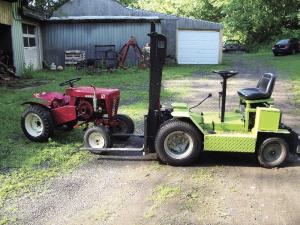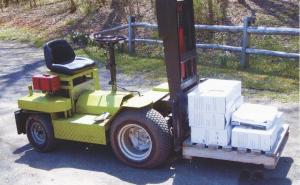2013 - Volume #37, Issue #4, Page #26
[ Sample Stories From This Issue | List of All Stories In This Issue | Print this story
| Read this issue]
"Mighty Midget" Forklift
 |
 |
The forklift he built measures only 5 ft. long by 3 ft. wide and is powered by a Briggs & Stratton Vanguard 14 hp engine coupled to a 3-speed transmission. It rides on big turf tires. The front ones are 23 in. high by 8 1/2 in. wide while the back ones are 16 in. high by 8 1/2 in. wide. The mast can lift loads up to 44 in. high and handles up to 1,000 lbs.
“It’s small enough that I can maneuver in tight places, yet low to the ground so it’s very stable. I don’t have to worry about tipping over,” says Schoonmaker. “With the big tires on front I can use it outside without worrying about getting stuck.
“I built it small on purpose because I wanted to use it in my shop which is quite small, measuring 70 ft. long by 25 ft. wide and with only a 9-ft. high ceiling. I had been using an old Clark forklift, but it was too clumsy and tall, says Schoonmaker. “It’s also easier to transport. I can load it on a double axle trailer along with a couple of my homemade tractors or some farm engines, and once I’m at the show I can use the forklift to unload everything from the trailer.
“I also use it to load 12-ft. logs onto my bandsaw mill. It also works great for handling logs when cutting firewood or doing other chores around my place.”
He started with the rear end off a 1970’s Cub Cadet garden tractor. The forklift is powered by a Briggs & Stratton 14 hp vertical shaft engine, which shaft-drives a hydraulic motor that powers a gearbox. The transmission is operated by stepping on a forward/reverse, foot-operated pedal. “I like being able to use a foot pedal instead of having to fiddle with a gearshift lever. Makes it easier to move back and forth,” says Schoonmaker.
The engine shaft-drives 2 pumps. One pump operates the tractor and the other one – originally designed for a pickup-mounted snowplow – operates a pair of hydraulic cylinders that are used to raise and lower the forklift and also tilt it forward and backward.
He made the forklift’s frame out of 2-in. sq., 1/4-in. thick tubing. A 275-lb. weight on back slides into the frame tubing for better balance when needed. “By pulling a pin I can slide the weight out in couple of different locations,” says Schoonmaker. “For example, if I have an unbalanced load I can slide the weight back which lets me lift more and also makes the rig easier to steer.”
The channel iron rails off an old appliance hauling cart form the forklift’s sides. A hydraulic cylinder chain-drives the mast to raise it up and down. Schoonmaker made the forks out of 3-in. wide, 3/4-in. thick bar stock.
“It’s a handy tool and was a fun project to build,” says Schoonmaker. “It’s built low to the ground for stability. It can only lift 44 in. high but I wouldn’t want to go higher than that since the machine is only 3 ft. wide.
“I already had most of the material that I used to build the machine and spent a total of between $1,000 and $2,000. I paid $200 for the engine and bought the steering wheel and some other parts at a tractor supply company. The steering shaft is enclosed in a piece of square tubing and is chain-driven to the rig’s rear steering wheels. I used rectangular tubing to build the hydraulic reservoir and mounted the gas tank on top of it.
“I bought the seat and many of the hydraulic components from Surplus Center in Lincoln, Neb. (ph 800 488-3407; www.surpluscenter.com). They deal in overages and end-of-the-line stuff.”
Contact: FARM SHOW Followup, Alan Schoonmaker, 4385 Hall Center Rd., Walworth, N.Y. 14568 (ph 315 945-9401; ahs_sbr@juno.com).

Click here to download page story appeared in.

Click here to read entire issue
To read the rest of this story, download this issue below or click here to register with your account number.




